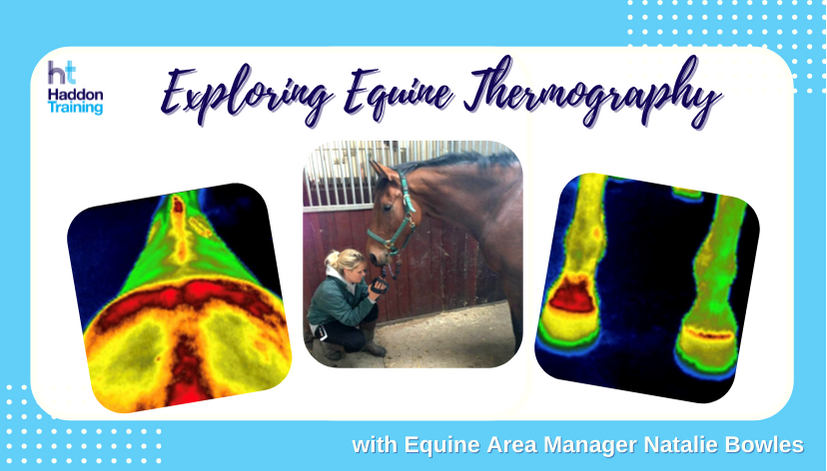
Our team are some of the best in the business. Our equine staff have many specialist skills within the industry, and we are delighted that they continue to utilise these alongside their careers at Haddon Training. We wanted to explore the many areas of expertise that our staff have and highlight how valuable these skills are; here we speak with one of our brilliant equine Area Managers, Natalie Bowles, about what led her to pursue her qualification in equine thermography and what it involves.
“I discovered my love for horse riding at four years old and was fortunate to be supported by my parents as I pursued a career within the industry. I have gained a lot of experience; I have worked on various yards in the past, including Head Girl for a 5* livery yard, managing a competition livery yard with my sister, and helping to establish a successful local riding establishment as both Yard Manager and Chief Instructor before joining the team at Haddon Training.
I first heard about thermal imaging whilst talking to someone who had trained as an equine thermal technician. I’ll be honest, I was initially sceptical about the technology. However, after offering to scan my horse Barney with no information about his medical history, the scanner identified specific areas of inflammation and detailed the arthritis in his near hind hock. I was instantly fascinated! I completed an equine thermal imaging technicians’ course with a reputable specialist company in Lancashire and became their independent equine thermographer for the Hampshire, Surrey and West Sussex area, alongside managing the competition livery yard I was at.”
What is equine thermography?
“Equine thermography is a non-invasive way to assist in the diagnosis of injuries within the horse, examine their performance and monitor recovery during rehabilitation. When a horse is scanned with a thermal imaging camera and specialist computer software, the camera maps the thermal condition of the horse and identifies abnormal thermal patterns which detects the location of increased activity or injury.
Before using a thermal imaging camera, the horse must be prepped correctly to avoid misleading results. This includes ideally keeping the horse out of artificial and natural light prior to scanning because this can modify the horse’s natural thermal temperature.”
How does equine thermography help diagnosis, performance, and recovery?
“It is vital to remember that only veterinary professionals can properly diagnose injuries, but equine thermal imaging can be incredibly useful in helping to identify the location of trauma and injury when you are not sure where to start. It won’t give you the diagnosis, but it will pinpoint the area.
Some professionals regularly have their horses scanned to assist in monitoring the performance of the horse by scanning pre and post work to ensure that the horse is using themselves evenly and correctly during exercise.
Horse owners can also opt to get their horse scanned as part of their yearly or bi-yearly routine, alongside the physio and saddler. This is simply to monitor the horse, overseeing long term conditions such as DJD, or just part of an overall check-up as a method of preventative care. It can be used by saddlers to help identify if a saddle fits a horse and sits evenly on their back; specific scanning can show if there are any pressure points created by the saddle, or if it is sitting unevenly.
Thermal imaging can help in the rehabilitation of a horse by monitoring the activity at the site of injury to ensure it is improving at the rate it should be.”
How do you start a career in thermal imaging?
“To be accepted onto a thermal imaging technicians’ course, the most reputable companies request that you have relevant experience in the equine industry and applicable qualifications, such as the Level 3 Senior Equine Groom Apprenticeship qualification, which confirms you have the sufficient equine knowledge and experience required to be able to interpret the images correctly. This apprenticeship includes a module on horse anatomy, physiology and welfare which can be particularly beneficial to those with an interest in thermography.
Once you become a qualified technician you can then choose how you wish to work. Some choose to work as a franchise enabling them to have all the support and backing of an experienced company. Others choose to apply their skills alongside other professions, for example an equine physiotherapist or saddler may choose to qualify in thermal imaging to enhance and expand the services they can offer to their clients.”
Thank you so much Natalie for taking the time to talk to us about this!
If you would like to know more about what we offer and how this can help you progress your career, please get in touch.